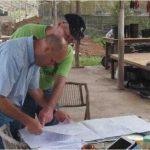Agland’s Role in Permanent Working Lands Conservation in California:
The Howe Creek Ranch in Ferndale California, was perhaps the first working2 forest conservation easement (CE) in the State. Along with the Parkfield Ranch3 in south central California, Howe Creek was also the first working-ranch CE in California. The Howe Creek transaction commenced in 1995 and concluded in 2002, and is owned by Agland Engineering’s President & founder4. In California prior to Howe Creek, CEs were oriented to convey significant management control to nongovernmental organization (NGO) land trusts. California’s conservation culture had evolved to that dysfunctionality with unbalanced environmentalists in leadership roles; unbalanced with no economic experience nor access to cultural history and husbandry.
Agland first became a landowner advocate facilitating CE transactions when, soon after the Howe Creek Ranch deal closed, a neighbor & several other ranch families asked Agland for help. That was the catalyst. Agland saw the potential beyond individual CE deal success, but rather, of well designed working-lands CEs with economic protection across a region. Agland also recognized that landowners had no experienced professional help available. The experience necessarily behind good advise did not exist. CEs prior to Howe Creek were transacted between land trusts and mostly absentee heirs. Consequently ranch & forest lands were being stripped of their potential for economic productivity and husbandry. The deals were resulting in restrictions untenable to a tree farmer or rancher.
Agland was dialed-in to the problems of resource land business succession, from its ties with the ranching & forest appraisal & ag. finance industries, and direct participation in county level farm, livestock and forest industry associations. Indeed Agland evolved out of need through the personal experiences of its founder.
Our rural economies & cultures are in crisis. Not since the decade of the 1970’s has the cost of succession been equal to the potential of paying those costs from agriculture. Consequently, either conversion to non-ag, or corporate absorption of family owned aglands is inevitable. The crisis is that most landowners won’t see it coming; it’s only evident during generational succession, and with traditional farm & ranch families this can be 40 years or more. It will however, become obvious to every ranch and forest family eventually.
The landowners seeking CE advise after the Howe Creek transaction closed, were all at a critical succession stage, and like Howe Creek, the landowner’s needed to remove non-ag capital from the market value of their resource-land asset. Agland along with six ranches and their law firm Hendrickson Law, envisioned and created the Six Rivers to the Sea (Six Rivers) CE project as a vehicle for ranchers & forest owners in Humboldt County. All of the Six River’s Landowner’s chose Cal Fire as Grantee, and Agland & Hendrickson Law negotiated the CE terms with Cal Fire. Agland Engineering & Hendrickson Law also created the Klamath Cascade project while working with several ranchers and forest landowners in Siskiyou and Shasta Counties.
NGOs like the Trust for Public Land, the Nature Conservancy had been dictating terms in California’s conservation community. Cal Fire was chosen as a grantee for the Six Rivers project because of its Forest Legacy Program (FLP), which was the only potential grantee willing to work with a practicing ranching and logging landowner 1998. FLP has evolved with the Six Rivers and Klamath Cascade projects, was their most important catalyst, and today remains the most important advocate of working lands CE integrity in the State.
